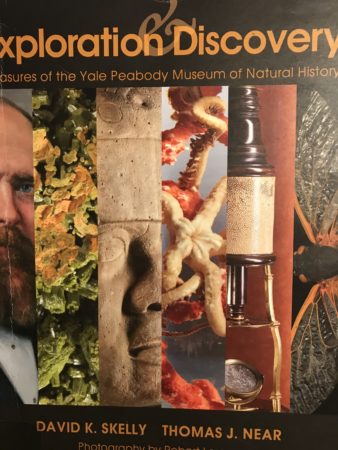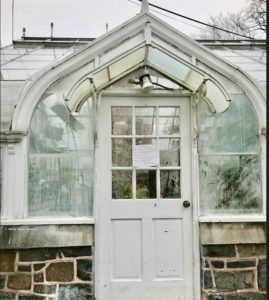An O. C. Marsh Trail
Dots on a map connected make a trail.
Change. Ebb and flow.
On a living planet, all is recycled and time ticks ever forward. Sprout, grow, bud, blossom, reproduce, age, extinguish, return to earth. The forms and functions shaped by adaptation in the botanical world are actually solutions presented in nearly every possible environment. You can find the world in a garden with connections to New Haven history where the past, present and future intersect. Or see into deep time by reading the landscape and then reading more.
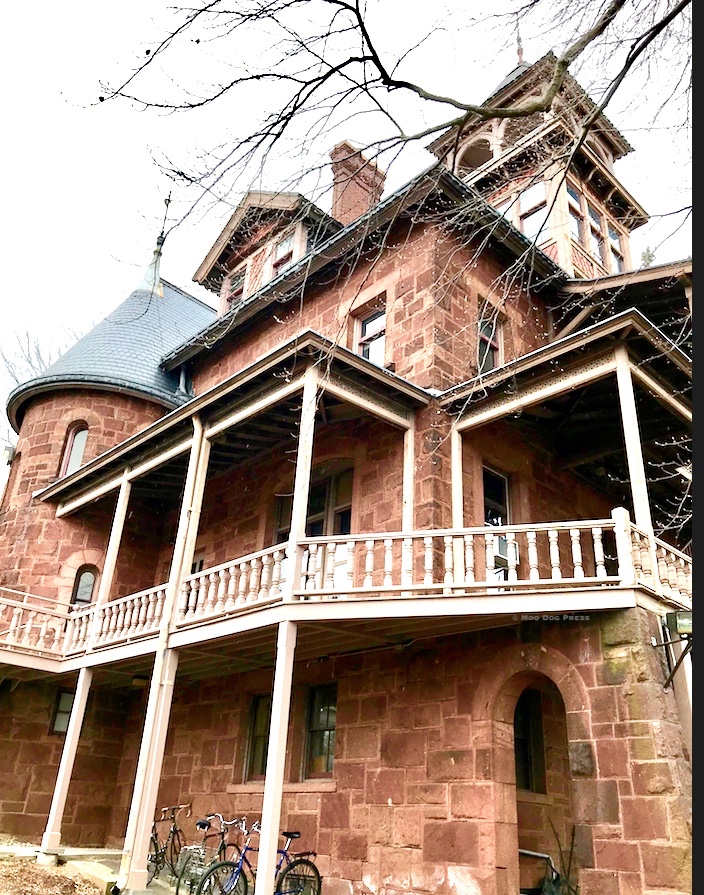
The former home of O.C. Marsh in New Haven, Connecticut. Architect J. Cleaveland Cady also designed the Yale Peabody and many other notable structures including the American Museum of Natural History (first building of the group facing the street, New York), and others at Trinity College, Wesleyan University.
Study the work of others and build upon that something new, add to the world (not subtract). A living library of sorts connects the life of O.C. Marsh with the Yale Peabody Museum of Natural History (YPMNH) in New Haven, Connecticut; the latter is going through an expansion and renovation and is soon to re-open in 2024. Those interested may tune in to view progress behind the scenes via social media; Facebook or Twitter. Fascinating glimpses of the curation are sometimes featured along with construction and familiar interiors.
The Marsh Botanical Garden is a sloping landscape with naturalized plantings, massive oaks and beeches, greenhouses. The ongoing work to clear and restore the gardens is complemented by greenhouses below and the former home of O.C. Marsh (now headquarters for the Yale School of Forestry and Environmental Studies) above, at the top of the hill. (Go ahead, try to describe the building, a fantastical story of a structure with a tower and steps and…. Or better yet, visit and see with your own eyes. Stone, wood, chimneys. Archways and porches. Unique and fascinating, built and suited to the life and mind it would contain, then be preserved by his will and legacy.)
For those who who love landscape architecture and gardens, the “bones” of the plantings are emerging. Stroll the grounds to discover what is in bloom, image the quiet natural wonders found. (Growing up, one neighborhood home housed an artist who also was a botanist; the crocus and other plantings that appeared each spring were seen and remembered by a child who knew not the names but anticipated the annual displays, then grew and turned to books and the library to learn names, how to cultivate these bulbs and more. One life's work adding to another.) A walk in the gardens is simply a delight in any season.
To add to a visit (before or after or while staying home), two books: Exploration & Discovery: Treasures of the Yale Peabody Museum of Natural History by David K. Skelly and Thomas J. Near with photography by Robert Lorenz, (2016) distributed by Yale University Press. Forward by James Prosek.
House of Lost Worlds: Dinosaurs, Dynasties, and the Story of Life on Earth by Richard Conniff (Yale University Press 2016). Dedicated to the “scientists of Yale Peabody Museum of Natural History,” the illustrations and images alone are a portal to feed the imagination. Here is what the interior of Marsh's home once looked like on page 112. And about the design of the house “…in 1876, O.C. Marsh put J. Cleaveland Cady, the architect of the Peabody Museum building, to work designing an 18-room mansion on a 6.8-acre property at the top of Prospect Hill, just up from the Yale campus.” The book is an immersive read/tour into time, personalities — how the museum and collections evolved.
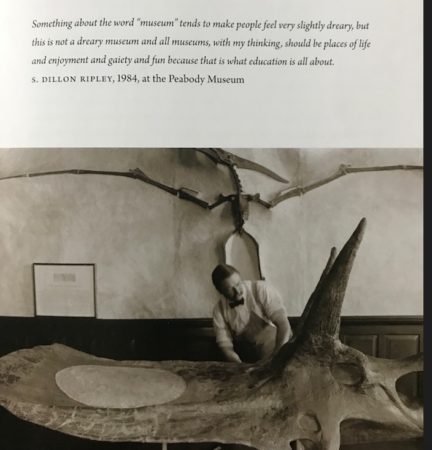
From House of Lost Worlds: the introduction page sets the pace for this wonderful literary journey into both the life of O.C. Marsh and the Yale Peabody.
The site itself is an artifact that provides important context to the museum of natural history — here is where ideas started and grew, decisions made. While standing downhill on the site and looking up, imagine interpretive walks and tours paired with augmented reality, holographic “ghosting” of the era of Marsh with his guests and his belongings that were in place at the time. Here is where things happened and shaped the future.
The Marsh Botanical Garden takes its name from paleontologist and dinosaur discoverer “Othniel Charles Marsh, whose uncle, George Peabody, founded Yale’s Peabody Museum of Natural History. The area that encompasses the Gardens was once Marsh’s estate, with Marsh Hall being his former residence.” From the official site, a timeline: “1899 • O.C. Marsh leaves instructions in his will for the donation of his house to be used as the new home of the first forestry school in the United States. The grounds are to be used as a botanical garden. Upon his death in 1900, the house and grounds become part of Yale’s campus.
“1922 • Beatrix Farrand begins her decades-long relationship with Yale and Marsh Botanical Garden. With systematic plantings, a rockery, a small greenhouse and nursery, a formal garden patterned from the oldest existing formal garden in Padua, Italy, the garden was at its height in the 1930s and early 1940s. With a large work force and other resources devoted to its upkeep, the garden drew thousands of visitors per year…” (Read more.)
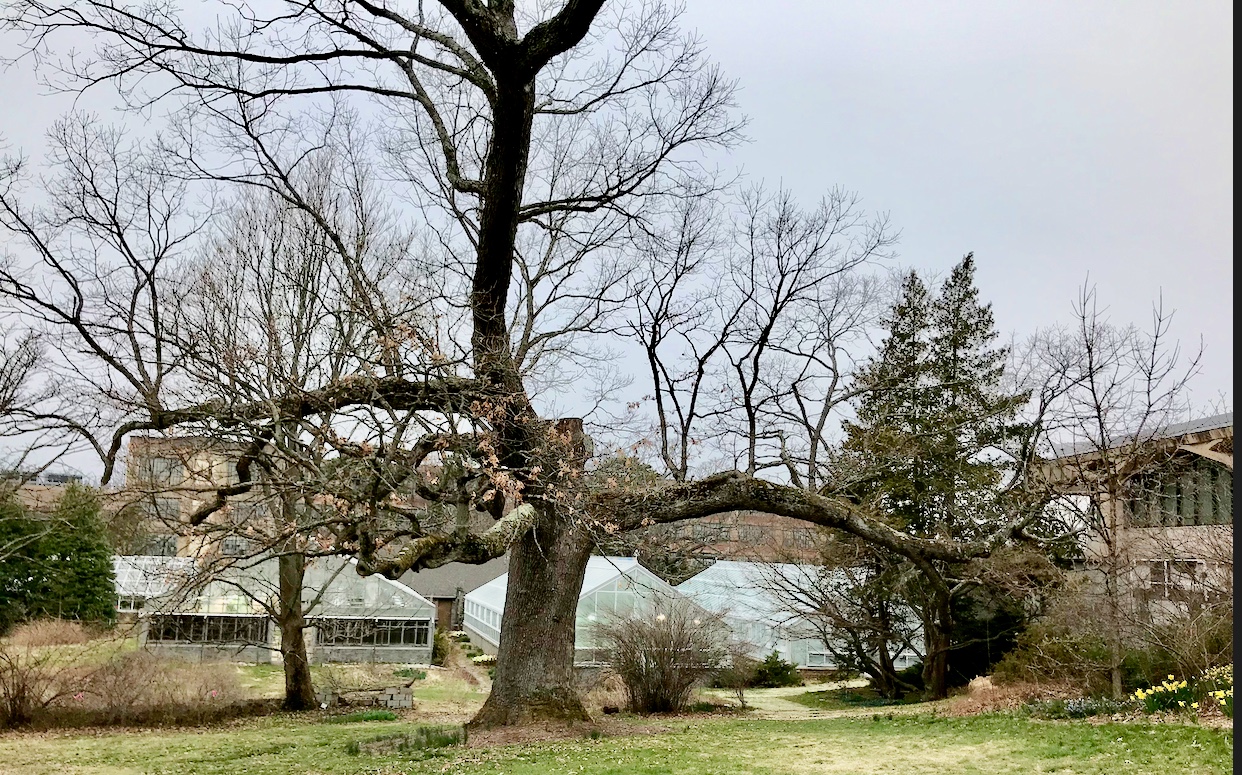
An old oak that was there when O.C. Marsh lived here has character and has survived storms. As seen a few years ago. Naturalized daffodils and other spring bulbs still accent the landscape.
From the official site, descriptions and history:
“Some of the systematic collection plantings that Beatrix Farrand (famed landscape architect) had designed into the garden still exist, with ericaceous plants taking the lead. Rhododendron, azalea, pieris, mountain laurel and blueberry provide spring, summer and fall displays. A native plant bog garden is nestled next to one of the springs that pop out of our hillside. Wildflower displays in the summer months, from May into October, provide an interesting alternative to the lawn in several areas. Garden beds near the greenhouses provide color as well with perennial and annual plantings, including a large planting of tender bulbs (gladiolus and calla lilies) that stay in the ground protected by the foundation of a greenhouse. We also have a large number of Asian plants, including several types of Japanese maples in the Honorary Ian Sussex Moss and bryophyte garden. In that same area are growing several camellias and leycesteria, protected from the winter weather by a south-facing nook near the koi pond and contemplation seat.”

